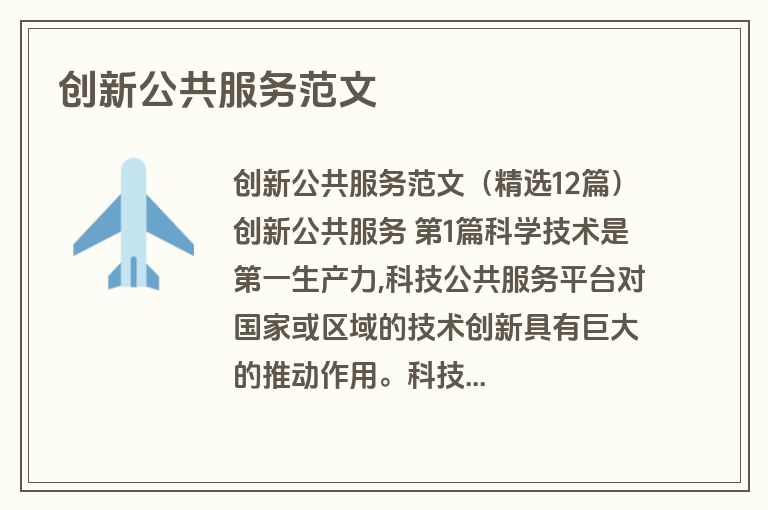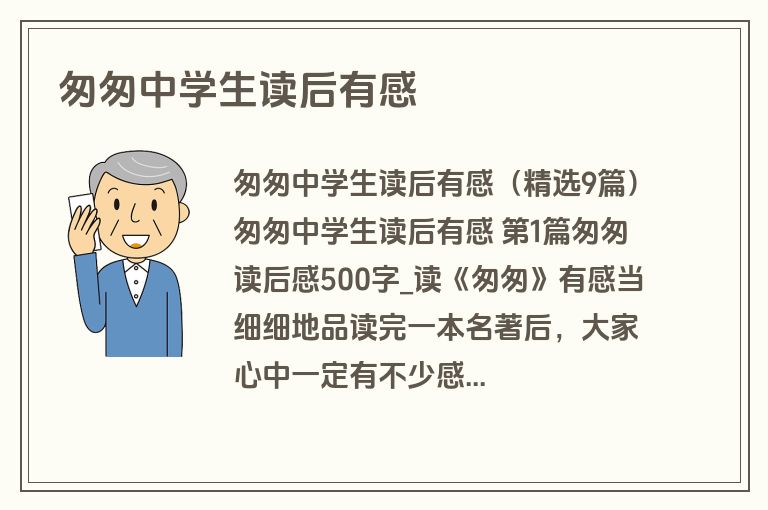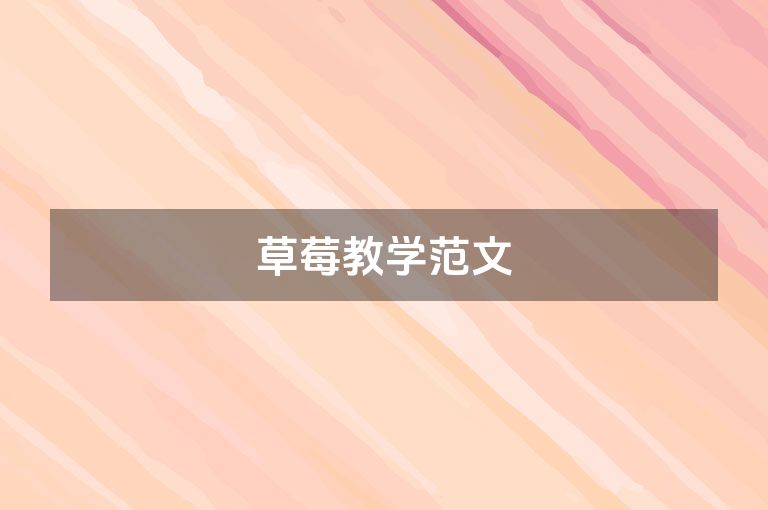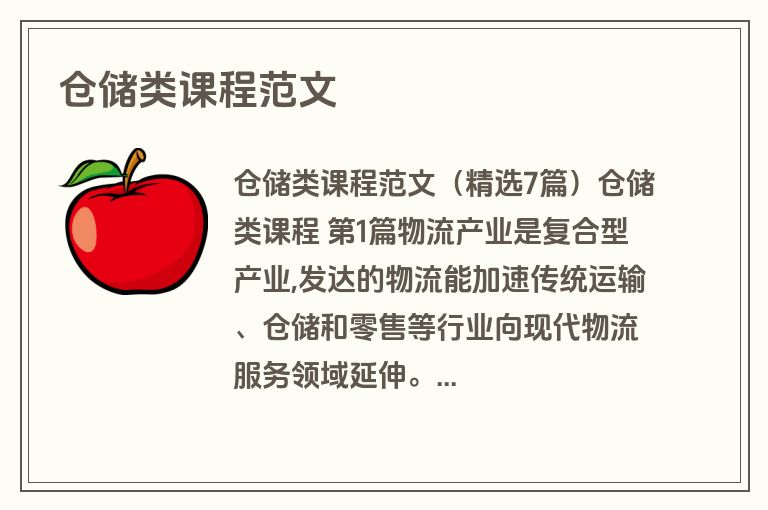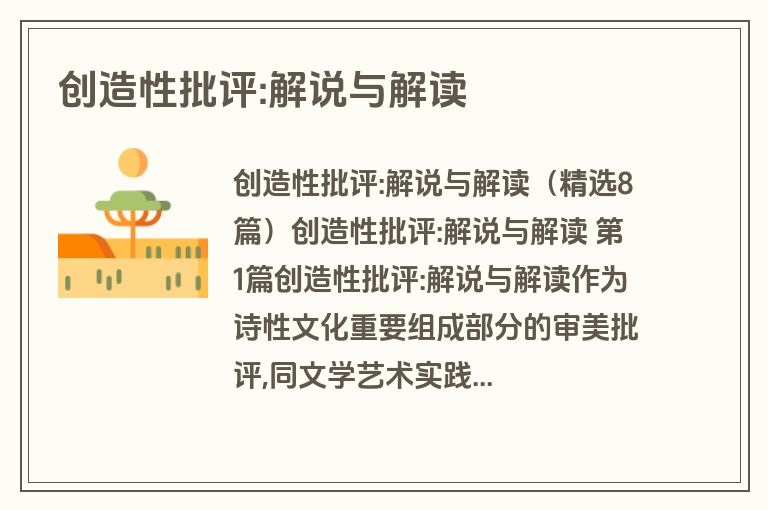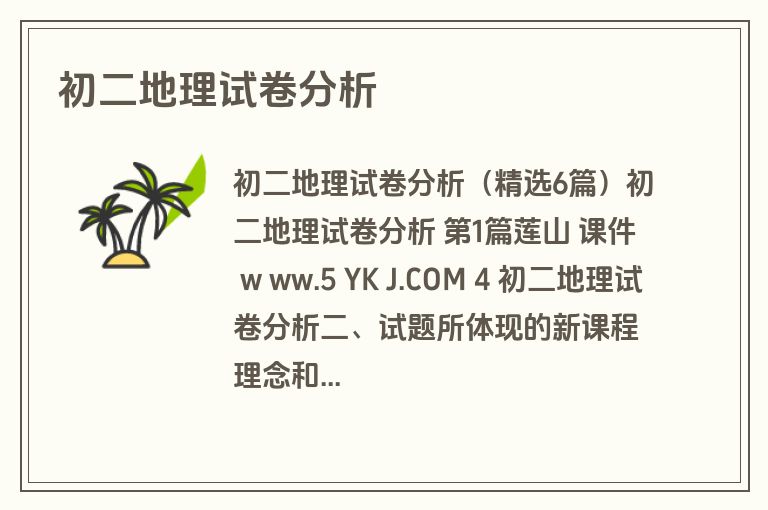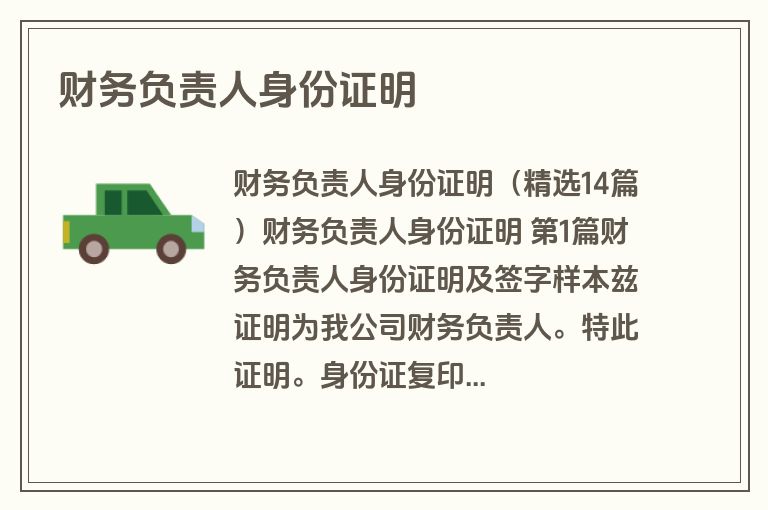各地景点的导游词英语(精选6篇)
各地景点的导游词英语 第1篇
Good morning ladies and gentlemen;
Today, we will go to visit Hubei Provincial Museum. On the way to the museum, I d like to show a present to express my warmest welcome to you. You may wonder what the present is. Well let me introduce it to you. The music you are going to listen to is the very gift. Now, please enjoy the music.
Have you ever listened to the music? And what musical instrument is used to play the beautiful melody?
That’s the serial bells, a wonder in the world. Indeed a wonder in the world. Every year tourists from all over the world continuously come to visit them and appreciate the programs played by it. Each year they return with unforgetable memory.
The building with red wall and green tiers before us is the very museum, Hubei Provincial Museum. Constructed in 1953, the museum is the center for collecting, studying, preserving and displaying historical and cultural relics in Hubei. More than 700,000 ancient relics are stored up in it. There is a collection of 100,000 books on history, archaeology, art etc. These relics provide precious material data for studying the development of history, culture, art, science and technology in ancient China.
Situated in the middle reach of the Yangtze River, Hubei has a long history and rich land. As early as 2,000,000 years ago, our ancestors lived and worked here and gradually they began to create their own civilization. The relics unearthed from Zenghouyi Tomb are good proofs to the civilization. The relics displayed in the museum are most from the tomb. Serial bells are the most precious and greatest of them all.
Are you familiar with the history of the serial bells?
It is said that it is the oldest musical instrument kept in the world. You see, our ancestors already knew how to use music to enrich their lives so long ago.
Luckily indeed, our archaeologists discovered it by accident and thus displayed the marvelous ancient civilization of Chu State in front us.
In 1978, a soldier discovered a large tomb when building his house. It was really a great surprise to discover it at that time. Afterwards, archaeologists excavated these serial bells on the same spot. This was appraised to be the tomb of Zenghouyi. It was220 square meters, 20 metros deep, consisting of 4 tombs. The main coffin was made up of huge internal and external coffins. The man in it died at the age of 45. Those buried alive with the dead were all female, aged from 13 to 25. They were in 21 coffins.
Besides the serial bells, more than 7,000 other historical cultural relics have been unearthed, such as bronze ware, ancient musical instrument, weapons, golden ware, jade ware, painted ware, wooden ware, and bamboo ware. Most of them are unique art treasure and they were deliberately made.
What is especially worth mentioning is the ancient musical instrument, such as serial bells, stone chimes, drums, 25-stringed plucked zither, and bamboo flute. They are totally 8 types, including 124 pieces. The entire musical instrument is placed perfectly among the bronze serial bells. They make the tomb look like an ancient concert hall.
Today the underground concert hall has come back to life. As a major instrument, 64 serial bells are put in the middle room, lined along the north and west wall. It can be concluded that serial bells are Zenhouyi’s favorite, for his body was placed in the west room.
As wee see, these big bells are shaped like round-bottomed baskets; small ones are like warming pots. They are hung in 3 layers from the winding bell shelf that is 13 meters long, 2.7 meters high. The whole bell shelf is supported by 6 human-shape objects. It is as strong as newly cast.
Ok, let me give you a brief introduction about the elegant ancient serial bells. All the bells have been played. They are all carved with inscription about musical melody. Each bell can produce 2 pitches. After many years of research, we find that its amplitude approached the international level of today. The combined scale is the 7 notes in C major of today. Its compasses very side, including 5 and a half octaves. The whole sound may be adjusted. Its wooden shelf is quite exquisite. Although buried for 2,400 years, the serial bells are well played. It not only can be used to play with to produce scores with the same melody, but also can produce mixed sounds though harmony and repeat tunes. Chinese musical pieces, such as Intoning Three Times Before Leaving Yang Pass, The Moon On The Spring River, and foreign pieces, such as Christmas Eve, can be played on it, even Beethoven’s Ode to Joy in the Ninth Symphony can be. Foreign tourists are usually attracted by the fascinating music when listening to the Chinese song The Night On The Prairie. When foreign songs cut in, they are shocked by the old civilization of Chu State. As the famous violinist, Menuin praised it, The grand Greek music is accepted by the world. However, the musical instruments in ancient Greece were made of wood, what’s more, not a single instrument is kept till today. Here we are able to enjoy the sound of the instrument of 2,000 years' history from the tomb of Chu State.
Actually, whoever enjoys the music played on the serial bells will be surprised at the great achievement made by the people of Chu State in the fields of music, culture, smelting, and casting.
According to the history, Chu State was called the state of rites and music at that time. People in Chu State love dancing. They danced in the palace and sang in the room. They knew how to enjoy dancing and singing. We can imagine the following scene. The host of the bomb was seated in his palace and watched the girls dancing. On both his sides sat his followers. They sat on the floor. A table with short legs was placed in front of them. They put one hand on the table that is used to hold arms. This can be proved by the relics in the tomb.
Do you know, in China, a male and a female mandarin ducks are the symbol of love, for they often play together in the water and live together. Can you see the box here? This box was found in the tomb. The box was painted. It was empty in it. But there are some pictures. They describe a very vivid situation; some people are striking bells, beating drums and dancing. This picture is very precious, for we can know how these instruments should be played, especially the serial bells.
I wonder if you have noticed that there is only one mandarin duck on the box. Do you know why? Oh, he is abandoned by his lover. But he found a new company―music. He didn’t heed the other mandarin duck, for what he really loved was music.
Well, I have a question. What is the tourists’favorite?
The music played on the serial bells.
各地景点的导游词英语 第2篇
广东省2012第一次全国导游人员资格考试
各地市口试景点列表
一、广州
1.珠江夜游 2.番禺宝墨园3.广州光孝寺
2.粤晖园
3.南社明清古村落
十二、中山
1.孙中山故居纪念园 2.詹园
3.岭南水乡
二、深圳
1.世界之窗
2.明斯克航母世界 3.深圳锦绣中华
十三、江门
1.新会宋元崖门海战文化旅游区 2.陈白沙纪念馆
3.歇马举人村旅游区
三、珠海
1.珠海梅溪牌坊2.珠海农科奇观 3.海泉湾
十四、阳江
1.阳东东平大澳旅游区 2.春湾风景区—龙宫岩 3.阳江海陵岛
四、汕头
1.中山公园 2.莲花峰风景区 3.礐石风景名胜区
十五、湛江
1.湛江港
2.南亚热带植物园3.廉江鹤地银湖
五、佛山
1.佛山祖庙 2.南风古灶 3.顺德清晖园
十六、茂名
1.根子荔枝文化旅游区2.茂名森林公园3.天马山生态旅游区
六、韶关
1.南岭国家森林公园2.金鸡岭风景名胜区3.南华禅寺
十七、肇庆
1.德庆盘龙峡生态景区
2.肇庆阅江楼—独立团团部旧址3.封开龙山景区
七、河源
1.新丰江水电站景区2.越王山旅游区
3.黄龙岩畲族风情旅游区
十八、清远
1.南岗瑶寨
2.英西山水野外逍遥游 3.贤令山旅游风景区
八、梅州
1.五指石风景名胜区 2.丰顺龙鲸河漂流景区3.汤湖热矿泥山庄
十九、潮州
1.绿岛旅游山庄 2.潮州西湖公园3.潮州淡浮院
九、惠州
1.惠州西湖 2.罗浮山
3.港口海龟国家级自然保护区
二十、揭阳
1.三山国王庙 2.黄满磜瀑布 3.黄岐山
十、汕尾
1.陆丰市金厢滩旅游区2.凤山祖庙旅游区 3.彭湃故居
二十一、云浮
1.国恩寺
十一、东莞 2.一代抗日名将蔡廷锴将军故里
各地景点的导游词英语 第3篇
一、导游景点讲解能力的重要性
导游景点讲解内容主要围绕着景点的自然风光、人文背景等话题,通过语言的加工,形成适应于不同游客的言语,从而营造出一种情景再现的感觉。由此可见,语言是导游与游客的主要互动工具之一,它将两者紧密联系在一起,语言表现的好坏直接影响着导游的讲解能力,因此,需要导游具有较强的言语功底,通过巧妙运用言语,满足游客对景点的认知、求学、娱乐、享受。在旅游行业中有这样一句话:导游一张嘴,丑的也变美。这句话深刻体现出导游对于景点的讲解能力的重要性,实际中导游可以说是一个靠嘴说话的工作行业,因此讲解水平直接影响着导游的工作质量。
二、中职导游专业学生景点讲解中常见问题
中职导游专业生源是初中毕业生,相比之下其文化程度较低, 因此不可避免的带来一些负面问题,包括知识点的累积不够、社会经验不足等,这些都会影响到其对景点的讲解过程,下面简要归纳其中常见的问题。
(一)内容千篇一律,缺乏创新
由于中职导游专业学生的生源来自于文化程度相对较低的初中,而初中学生对于知识面的把握能力相比于大学生还是存在一定的差距,因此其只能通过相对狭窄的知识面进行景点讲解,讲解时往往照本宣科,内容千篇一律,无法进行内容、形式多变的知识点讲解。比如对博物馆旅游者讲解时,根据展览物品的顺序依次解说,单一枯燥的演示历史、背诵典故等,灵活变通、富有新意的讲解极少。
(二)缺乏讲解技巧
对于刚学习的学生而言,无法进行有针对性、科学性、灵活性的讲解,更加不会巧妙运用讲解技巧,所以无法对游客进行不同层次的讲解。
(三)讲解结构单一
导游专业学生的学习过程深受网络和书籍的影响,因此学生在对一个景点进行讲解时候容易直接背诵事前查阅到的资料,并忽略资料的创新,长期下来容易造成整个讲解结构的单一化,学生自己也容易深陷其中,无法摆脱该种结构。
三、培养中职导游专业学生景点讲解能力
针对上面提出的中职导游专业学生在景点讲解中常见问题,我们提出以下解决措施,旨在提高中职导游专业学生的景点讲解能力。
(一)提高学生的个人素质,拓宽知识面
导游行业要求从业者是宽广知识面的高素质人才,因此学生的培养应当包含知识面和素质的培训。首先,知识面方面,因为学生大多数只有初中文化水平,知识面相对较窄,因此在学习过程中除处理传授必要的导游相关知识课程之外,还需要传授一些具有一定特色的课程,比如民族、宗教、文学等方面的课程, 从而提高学生的知识面。另外,个人素质方面,在学习过程中还需要注重培养学生的个人素质,通过能提高个人素质修养的相关课程来实现。通过这两方面的学习,从而提升学生的整体能力。
(二)增强学生的语言表达能力
导游工作主要内容是进行语言描述,因此语言的表达能力直接关系着旅游行业的发展。所以,一方面需要保证景点讲解过程中涉及景点的信息点必须准确可靠,不可胡编乱造、信口开河。另一方面,不同的参团人员有不同的文化背景,因此必要时候需要通过口语化方式讲解,从而保证游客对景点的清楚认知。 基于上述情况,在学生的教学过程中需要注重特定解说词的口语化。
(三)强化学生表达技巧
表达技巧源于游客对于景点讲解的认知程度,通常生动形象的表达技巧有助于游客对该景点留下深刻的记忆。因此在学生培训中应当注重表达技巧的培训,可以通过使用修辞手法的方式提高语言表达技巧。
随着旅游行业的兴起,对于导游人才的需求越来越大,然而对于导游人才技能的要求又严重影响着导游人才的引进,因此我们需要更多从学生时代关注导游专业学生对于景点讲解能力的培养。通过学生的努力学习,深入了解景点,此外还需要在培养过程中通过科学的方法进行,这样才能最有效地获得导游人才。
参考文献
[1]江婷.浅谈中职导游专业学生讲解能力的培养[J].成才之路,2011(12).
[2]徐进.中职导游专业学生导游讲解能力的培养[J].才智,2011(23).
各地景点的导游词英语 第4篇
关键词:英语导游;景点解说;问题
引言
旅游业作为一个新兴产业,在中国取得了非常大的发展成就。作为有着悠久历史的文明古国,我国的历史文化,自然风景,风土人情都以其独特的魅力吸引着八方来客。值得注意的是,随着大量外国游客的涌入,英语导游在景点解说的过程中出现了很多不合适的表达与景点介绍。特别是在解说一些具有中国特色的传统的旅游文化景点,很多英语导游无法或者很难将中国的特色文化进行地道的英语表达。这种由于语言的不匹配而造成的信息交换的不畅通是我们亟需面对和解决的问题。本文通过从总结英语导游在景点解说时应该注意的问题入手,尝试提出了一些相关问题的解决策略。
一 英语导游在景点解说时出现的问题
英语导游在引导外国游客进行参观时发挥着极其重要的作用。可是由于主客观原因,很多英语导游在进行景点解说时容易出现一些影响外国游客理解和接受的解说方式和问题。具体表现在以下几个方面:
首先,景点解说方式与内容的过于简单粗糙,无法帮助外国游客在聆听过程中感受到景点的文化与魅力。景点介绍的主要目的是帮助外国游客对所参观的景点进行深入的了解和学习,从而激发他们参观的积极性与好奇心。如果英语导游在解说时,缺乏对景点的细致描述,对一些具有历史文化意义和重要文物价值的景点,在介绍时只是一笔带过,缺乏细致入微的讲解如描述,则会降低游客对参观景点的期望值。例如,在一次外事旅游中,一个英语导游在向外国游客介绍我国著名的风景名胜区少林寺,千年古刹时,直接将这一伟大的文化建筑翻译为:Shao lin Temple, an old house of thousand years. 这种简单化的翻译会把少林寺的灿烂形象大打折扣。在外国朋友的理解意识里,少林寺只不过是一个老房子而已。所以,在英语导游对景点解说时要尽量避免这种过于简单的景点解说。
其次,景点解说时,缺乏对游客宗教信仰的考虑与尊重。外国游客,特别是欧美国家,他们大多数都是虔诚的基督徒。在他们的信仰文化里,上帝耶和华是他们唯一侍奉和敬拜的神。所以,我们在进行涉及宗教文化的景点介绍时,要客观理性的对景点所代表的寓意和文化进行介绍,要避免在英语解读的过程中掺杂自己的主观情绪,特别是不能出现对自己之外的信仰的歧视甚至抨击。这种缺乏宗教信仰与尊重的景点解读方式,在实际的英语导游的日常工作中一定要格外注意和避免。因为,一旦这样的常识性错误发生会严重影响外国游客对我们的接受和认可程度,严重时,还会引发沟通的障碍与危机。我国著名领导人周恩来总理曾经一再强调:外事无小事。因此,我们英语导游的从业人员,应该具有高度的责任感与从业的使命感,在从事对外导游的翻译过程中,注意语言的措辞与礼貌。一方面要完整展示打过外语导游的风范,另一方面,也要做到有礼有节,不卑不亢。但是总体来说,翻译沟通过程中的准确与得体还是要放在外语导游的表达要求的首位的。
最后,景点解说时牵强附会,自圆其说。英语导游是一个比较严谨的工种,对导游自身的语言素养有着比较专业的要求。如果,英语导游在进行景点解说时,明明不是很清楚某一景点中某一事物的具体的英文表达,不是主动示弱,而是依然用自己不是很正确的方式进行强制性的解说。这种牵强附会的英语解说,不但不会促进外国游客对我们景点的欣赏,反而会讓他们对我们的专业度与服务质量产生怀疑。正如,我国春秋时期的大教育家孔子曾经说过的一句话:知之为知之,不知为不知,是知也。由此可见,英语导游在语言上的严谨,从某种程度上,也体现出了一个人的文化道德修养。
二 针对英语导游在景点解说时所出现问题的应对策略
有位哲人曾经说过:问题在事物的发展中扮演着两种不同的角色。一种是,绊脚石。一种是,垫脚石。前者会阻碍我们的发展与前进。后者,则会促进我们往前发展。因此,我们首先要正视和重视英语导游在景点解说时所出现的问题。只有树立了良好的问题应对态度,那么接下来的解决策略也会更有针对性与效果性。
1强化英语导游从业人员的专业素养提升。针对景点介绍的语言表述问题,正如上文所提到的,要么不知以为知,给国外游客造成不好的影响,要么在景点翻译过程中出现了明显的语言表达的常识性错误。这些现象产生的原因之一就是英语导游自身的英语专业素养的不过关。英语导游对其自身的英语交际水平有着比较高的要求。一方面,英语导游要有着比较高的英语表达水平,包括语言表达流利度与发音的标准等等。另一方面,英语导游要在除语言之外的其他领域也要有所涉猎,例如,历史,文化,古玩,建筑等等。只有对这些文化事物,特别是在景点介绍时所能用得到文化材料要尽可能多地去掌握。因为,英语解说时一个综合素质能力要求比较高的行业。
除了英语导游加强自身的知识积累与学习之外,国家政策部门及相关教育机构,应该从职业教育与培训的角度来对上岗的英语导游进行职业技能的考核与监督。一方面,要严格贯彻英语导游的选拔与考核制度,只有从源头上,提高英语导游从业人员的素质才能有助于英语导游景点解说的准确与得体。另一方面,要从终身教育的高度,在引导和鼓励甚至要求英语导游从业人员,在一定工作时间段后,回炉重造,也就是我们常说的“充电”。因为这是一个信息爆炸的时代,没有一种工作不要求知识与经验的不断与时俱进。只有在工作中学习,在学习中工作,两者互相促进才会真正意义上地实现英语导游翻译事业的蓬勃发展。
2建立英语导游翻译的规范与标准。需要指出的是,21世纪是一个标准化的世纪。只有实现标准的统一才有利于国际间更好的交流与合作,英语导游也是一样。我们只有加强与国际的合作,互相交流,制定标准才有利于求同存异,共同发展。具体来说,旅游部门应该与英语翻译协会建立互动机制,面对旅游景点介绍过程中所出现一些翻译盲区,应该发挥专家智慧。只有尽快地把各个旅游景点介绍标准的统一与科学,才会有助于英语导游在景点介绍时的统一表达,从而避免了同一景点不同的翻译而导致的国外游客的不解甚至误解。当然,在标准与规范制定的同时,我们还要充分考虑到中西之间语言,民族,宗教信仰等方面的差异。这种差异会影响到我们景点介绍时,英语导游的发挥。但是,凡是不可以过于追求标准化。主要是,每一个英语导游在日常的工作中会有自己的特色与特长,应该鼓励他们在统一严格要求下的个性的发挥。
3 通过在海外举办一系列的中国文化宣传活动,促进外国游客对我国文化的学习与了解。目前,我国已经在数十个欧美国家建立了孔子学院。这些孔子学院在帮助世界了解中国方面发挥了重要的作用。在英语导游的解说过程中,我们所认为的难点主要来源于外国游客对我国景点文化的不了解或者知之甚少。通过孔子学院这样的形式可以非常迅速地实现民族传统文化的传播与发展。只是,单单靠这种官方的文化传播是不够的。我们应该发挥和贡献更大的民间文化传播的力量。我们的电影,我们的电视剧,我们的综艺节目,我们的广场舞都是近几年来兴起的民族文化的传播者。可以说,我们每一个中华儿女都是我国伟大文化的宣传大使与品牌代言人。我们应该注意我们的言行举止,珍惜我们的国家声誉与形象就像珍惜我们的眼睛一样。
结语
英语导游需要在景点解说过程中注意很多问题,但归纳为一点就是对景点介绍的准确与得体。如何才能应对这些问题,笔者建议:英文导游的从业人员应该不断强化自身的学习和综合素养的提高。国家各相关职能部门应该强化英语导游从业人员职业技能的考核。另外,相关景点介绍的统一标准化翻译也是非常必要的。最后,加强我国文化和形象在世界各地的宣传与传播,让中国走向世界,让世界了解中国。
参考文献:
[1] 何洁. 中西方文化差异与旅游英语翻译[J]. 发展. 2008(12)
[2] 黄晓玲. 旅游英语教学的实践探索[J]. 产业与科技论坛. 2009(05)
[3] 汪莹. 从中西文化差异的角度浅析旅游英语的语言特征[J]. 商业文化. 2010(04)
旅游景点的英语导游词 第5篇
The Palace Museum is located in the center of Beijing. It is also known as the Forbidden City in the old days. Actually it was the imperial palace for the emperors and served as both living quarters and the venue of the state administration in the Ming and Qing dynasties. Its name, on the one hand, comes from ancient Chinese astronomers belief that Gods abode or the Purple Palace, the pivot of the celestial world, is located in the Pole Star, at the center of the heavens . Hence, as the Son of God, the emperor should live in the Purple City. On the other hand, except for palace maids, eunuchs and guards, ordinary the Forbidden City and the Purple City.
It took 14 years to complete the magnificent palace. Construction began in 1406 and finished in 1420. The following year, in 1421 the capital of the Ming Dynasty was moved from Nanjing to Beijing. Starting from the third emperor of the Ming Dynasty Zhu Di to the last emperor of the Qing Dynasty Pu Yi, altogether 24 emperors lived here for a total of 491 years. 14 of then were Ming emperors and 10 were Qing emperors.
The Forbidden City covers an area of 72 hectares with a total floor space of about 163,000 square meters. It is rectangular in shape, 960 meters long from north to south and 750 meters wide from east to west with a10-meter high city wall surrounded and encircled by a 52 meter-wide moat. At each corner of the surrounding wall, there is a magnificent watchtower which was heavily guarded in the old days.
The Forbidden City now consists of more than 90 palaces and courtyards, 980 buildings with rooms of 8,704. Most of the structures in the Forbidden City were made of wood with white marble, stone or brick foundations. The building materials were from parts of our country. The timber came from Sichuan, Guizhou, Guandxi, Hunan and Yunnan provinces in southwest China. But in the Qing Dynasty, the timbers were transported from northeast China. Other construction materials, including brick, stone and lime, were used by both Dynasties. The golden bricks that paved the halls were manufactured in Suzhou, refined bricks used to build the foundation of halls were made in Linqing, and lime came from Yizhou. White marble was provided regularly by Fangshan County and glazed tiles by Sanjiadian.
The Forbidden City can be divided into two parts: the Outer Court and the Inner Palace. The Outer Court consists of three main buildings where the emperors attended the grand of rear three main buildings and the six eastern palaces and six western palaces where the emperor used to handle daily affairs and the living quarters for the emperor, empress and imperial concubines to live in.
The Forbidden City is the best-preserved imperial palace in China and the largest ancient palatial structure in the world. In 1987 it was listed as the world cultural heritage by UNESCO.
The Meridian Gate is the main entrance to the Forbidden City. It is called Meridian Gate because the emperor believed that the meridian line went right through the Forbidden City and his imperial residence was the center of the whole universe. It is 35.6meters high with five towers on the top, so it is also nicknames as the “Five-Phoenix Tower.”
The Meridian Gate was the place to announce the new lunar year calendar on the first day of 10th lunar month every year. Lanterns would also be hung up on the Meridian Gate on the 15th day of the first lunar month during the Ming Dynasty, when all the officials would have a feast in the Forbidden City and ordinary citizens, when all the officials would have a fast in the Forbidden City and ordinary citizens would go to the Meridian Gate to look at the beautiful lanterns. When a general returned from battle, the ceremony of “Accepting Captives of War” was held here. The “Court Beating” also took place here.
英语景点导游词 第6篇
英语景点导游词1
Bonjour, tout le monde! Se félicite de la visite à cette guilin, je les montagnes et l’eau sont les guides des visites guidées cette chen, si je les invite les membres de la commission, il n ′!
Nous voudrions ensuite de LiJiang, est très importante et LiJiang est guilin, si l’on veut aller doit aller LiJiang guilin. Bon, maintenant, nos travaux ici LiJiang trois caractéristiques de l’eau, et un repos, un LiJiang vert, l’eau est qu’un repos ne donne à la mobilité, vu les JiangDe d’agrégats vert, comme c’était déjà un des martin-pêcheur, chers amis, si elles ont été vus dans la mer, par exemple pour apprécier le niveau a cette occasion, mais qui ne peuvent pas être LiJiang et par ah!
Regarder de l’eau pour la consolidation de la paix, nous devons regarder montagne. Les trois guilin, show, chihuahua, risque, pourquoi? Sous一座座, des personnes agées, comme énorme, comme, à dos de chameau. Pourquoi beau? Comme la verdure comme nouvelles pousses de bambou. Pourquoi risque? Crête WuLi guatémaltèque, GuaiShi, YiBuXiaoXin mont-liban. Pourrait tomber de tout son long
Sao guilin! Vous êtes les bienvenus pour lui.
英语景点导游词2
Ladies and gentlemen, good morning, Today, we are going to visit the Museum of Terracotta Warriors and Horses. This museum is located at the foot of mountain Li Shan, about 35 kilometers east of Xi’an.First, I will give you a brief introduction about the master of this underground army---the First Qin Emperor, Yingzheng. He came to the throne at the age of 13 and seized the power at the age of 22 . By 221BC, he had annexed all the six independent states and established the first centralized autocratic feudal empire in the long history of China.
After the unification of the whole country, he styled himself the First Emperor and standardized the coinage, weights and measures, the legal codes, the written scripts and so on. He also ordered the linkage of the original Great Wall. All these exerted an everlasting influence on the long feudal history of China. But the First Qin Emperor was very ambitious. As soon as he came to the throne, he ordered that a magnificent mausoleum should be built for him. It took 37 years to complete this great project. Actually, the site of those terracotta warriors and horses we now see is just a small part of his mausoleum.
Ok, everyone, now we are standing at the front gate of the Eighth Wonder of the world---the Museum of Terracotta Warriors and Horses. As one of the top ten places of historical interest in China, it was also listed as a world heritage site.So next, let’s go to uncover the veil of this miraculous work.
In March 1974,when several farmers were sinking a well about 1.5km east of the First Qin Emperor’s Maosolem, they came upon many fragments of the terracotta figures.The results of archaeological excavation showed that is two more pits were discovered respectively.They were then named pit1,pit2, and pit3 by the order of discovery.The new discovery stirred up a sensation all over the world.In order to provide the historical artifacts with adequate protection, a musem was set up on the site of Pit 1 in 1975 upon the approval of the state council.
Pit 1,covers an area of 16,300 square meters, is an earth-and-wood structure in the shape of a tunnel. The terra cotta armies in pit 1 were arranged in battle formation. In the front of this formation, there are 210warriors in 3 lines facing forward. Armed with bows and arrows, they constitute the so-called vanguard. Meanwhile, there is one row of warriors on each of the borders of this pit, facing outward---they are the flanks and the rear guard. Holding long-distance shooting weapons, they took up the job of defending the whole army.Then, this way please. We may find ten partition walls which divided this pit into 11 corridors. The warriors standing inside them with horse-drawn chariots represent the principal military force of this battle formation. According to the density, there are over 6000 terracotta warriors and horses, and most of them are infantrymen.
Ok, Here now we arrived at Pit 2. we can see that Pit 2 is still under cover, that’s because we want to preserve them. Pit 2 consists of 4 different mixed military forces in four arrays, they are infantrymen, cavalrymen, archers and charioteers .And pit 2 also include many chariots and horses. They can be divided to act independently, capable of attacking, and defending with a quick response. As you see, those worriors, their feet, legs, bodies, necks, hands and heads, all with different faces, were all made separately and joined together. we may find they are all vivid and true to life.And also as we can see, here are some actual weapons unearthed in those pits. The most
attractive one is a bronze sword. Although it was buried over thousands of years, it is still very sharp. It can cat through 20 pieces of paper put together.
Now we come to pit 3. Pit 3 covers an area of about 520 square meters. There are only 68 warriors and 4 clay horses. The warriors were arranged opposite to each other in two rows, and only one kind of weapon called “SHU” had been discovered. This kind of weapon has no blade, and is believed to be used by the guards of honor. We have found many animal bones in the north side, and it is supposed to be “Prayer Hall”, and “Commander’s office” is on the south side. This suggests pit 3 is the headquarters directing the whole underground army.
Then we have arrived at the exhibition hall of Bronze Chariots and Horses. In 1980, two sets of large painted bronze chariots and horses were found. They broke into thousands of pieces when we found them and after 8 years’ careful restoration; they were rebuilt and open to the public. The first one was named “High Chariot” and the second one was called “Security Chariot”. They were the eariliest and most exquisitely and intricately made bronze valuables,and also the largest bronze wares discovered in the history of world archaeology.It provides extremlyvaluable material and data for the research of the metallurgical technique and technological modeling og the Qin Dynasty.
So now we will finish our journey in the museum today, I believe that you must be very astonished at this world wonder.So it’s your time,you can work around and take some pictures. thank you for listening~
英语景点导游词3
Ladies and Gentlemen,
Welcome to Beijing.Beijing is the capital of China as well as one of the four ancient capitals in china.Many foreign friends known Beijing because of the the success of the Olympic Games. Please sit back and relax. Iam your local guide for your Beijing tour ,you can call me Amry.This is our driver Mr. Zhang.We will make every effort to provide the best quality service.Like me, Beijingers are always ready to welcome friends from all over the world with their most hospitality.During you Beijing tour we will visit the Forbidden City、Great Wall、Summer Palace and other attractions.I hope that the old as well as fashion Beijing will leave you a good memory.
The first attraction of our tour in Beijing is the Forbidden City.The first thing people would think of when talking about the Forbidden City is it the place where Chinese emperors used to live and hold their courts. .But the value of the Forbidden City is not limited to this.It is a microcosm of Chinese history, Chinese culture and Chinese architecture.The Forbidden City is located in center oBeijing. It was imperial palace of both Ming and Qing dynasties.With a history of over 600 years, it is the largest and most complete palace complex that still exists in the world. 24 emperors had rule the empir from here for more than 500 years. Forbidden City is also called Purple Forbidden City .In the feudal[fju:dl]封建时代的 society ,emperors had supreme至高的 power , so this residence was certainly a forbidden place . Purple was the symbolic[simb?lik] 象征color of the North Star which was believed to be the center of the cosmos宇宙 .So it got the name of Purple Forbidden City.
The building arrangement within the Forbidden City is symmetrical对称的And it is divided into two parts :the outer court and the inner court .The former is the place where emperors handled courts事物 and held different ceremonies仪式.It consists of Taihe ,Zhonghe and Baohe Halls.Taihe hall is the largest hall within the Forbidden City.It was the location where Ming Dynasty and Qing Dynasty Emperors hosted their enthronement and wedding ceremonies .The inner court consists of Qianqing, Jiaotai and Kunming Halls where the emperor lived and handled day-to-day work.The lmperial Garden lies on north of the Kunming Hall. It looks like a natural picture.This is the place where the emperor and his family play.
Since the founding of new China, the Forbidden City has been well maintained.It was made part of the world cultural heritage list in 1987.Tody as the largest museum of cultural relics in China, it collected and displayed one million precious relics .
Now I want to ask you a question.How many houses are there in the Forbidden City? It was said that there were 10000 rooms in the complex of the Heaven Palace .As the son of the heaven , emperor had to build only 9999.5 rooms .Actually ,there are only 8707 rooms in the Forbidden City.
As The saying goes, seeing is believing.With curiosity, lets walk into the Forbidden City.Lets appreciate Chinese culture and feel the history of the rise and fall of the Chinese emperors.
英语景点导游词4
Ladies and gentleman:
I am very pleased to serve as your tour guide. Today we are going to visit the ancient town of Lijiang------before we get there, I?d like to give you a brief introduction to it.
Located in northwest of YN province, Lijiang is about 580 kilometers away from KM with an average elevation of 2400 meters. The population of Lijiang is about 1.12 million. Among which the population of Naxi the main nationality here, is 260000.so how about the surroundings of Lijiang.
Located in the north of Lijiang town, the Yulong snow mountains is the
southernmost modern marine glaciers in the temperate zone of the north hemisphere. the other famous scenic spots around Lijiang are--- the Laojunshan mountain, Lugu lake and the Tiger Leaping Gorge which are also very famous and attracted many tourists. The famous characteristics of Naxi culture are the 3 living fossils, they are----the character fossil. Created in Tang Dynasty, the Dongba character was regarded as the only existing hieroglyph; and the music fossil, the Naxi ancient music, later we will fully appreciate the beauty and mystery of the music, I will give you more details; and the third fossil is the human society fossil, the Mosuo matriarchal family.Most Mosuo people living near the Lugu lake still practice their ?walking marriage? custom. At night the man comes to the woman?s house and return to his house in the morning, so they live separately. Women manage the households and yield works, play a more important role than men in family life.
Now we have come to the ancient town of Lijiang, which enjoys the fame ?eastern Venice?. And it has another name-Dayan town, which literally means –a great ink slab, with Lion Mountain in the west and Elephant Mountain in the north, the ancient town is surrounded by green hills, so it looks like a jade ink slab. The town was first built in song dynasty and has a long history of 800 years. In it was listed in the world culture heritage.
Now we are arriving at the entrance to the town, as you can see, there is a big carved wall in front of us, from the figures on the surface of the wall, you can see a character who has similar image to a monk, but in Naxi culture he is a Dongba whose function is like a priest in Christianity, he plays a very important role in Naxi people?s life. Especially for faith.
Going ahead we will see a white screen with an inscription by former leader Jiang zeming on May 2 1997 meaning –the world?s cultural heritage: the ancient town of the Lijiang.
Now you can see the old town has no walls, it was said that the hereditary ruler of Lijiang used to be surnamed Mu but If this character Mu was surrounded with a frame or a wall, it would become an another Chinese character ---Kun, which means siege or predicament. So there is no stone wall surrounded, very different from other old town in china right?
Ok let?s pay attention to the two waterwheels, which are said to be lover waterwheels or mother and son waterwheels, but no matter what they stand for, they have the same meaning---they will nestle to each other for ever.
Follow me, Let?s walk up to the Yulong bridge, the spring from the Yulong snow mountain is divided into 3 branches and sub-branches to flow into the old town. So let me give you a tip, because there are so many streets and lanes in the town, it is like a maze. if you are lost , you can easily find the entrance to the ancient town by walking up any of the streams.
So everyone is here? Let?s go into the old town. The road under our feet is parallel to the streams which can wash the road when blocked up, so the streets are neither muddy in the rainy season nor dusty in the dry season. The town depends on water for existence, so there are so many streams that more than 350 wooden or stone bridges in the town were built. And the most famous bridges are the Baisui Bridge and Dashi Bridge which also called Men Bridge.
Through the Dashi Bridge, now we have come to the Sifang Street, which means Square Street. Because it looks like a Chinese seal meaning ruling everywhere, it is the center of the ancient town. The square street is surrounded by five main streets; they are Xinhua Wuyi Qiyi Guangyi Xinyi leading in all directions.
In ancient times ,it had been an important marketing center on the ancient Tea-Horse Road. The trade history was more than 300 years. But now many handicraft shops, tea houses and restaurants make it a sea of the visitors. In every Saturdays evening. The Naxi people usually gather and dance here, unfortunately today is Monday we can?t catch that fantastic night. And around the square there are many protected Naxi traditional building, the typical styles are “three houses and one screen wall” and “four houses and five courtyards. This building is called Kegong Archway, it was built 100 years ago to honor the 3 brothers passed the provincial official enrolling exams. The original building was 2 storied, but it was destroyed by fire and rebuilt as 3-story on the former site
Now the Naxi boys and girls are coming, you can see the Naxi men have the same clothes as Han people, on the contrary, most Naxi women wear blue blouses and trousers, covered by blue or black aprons. The T-shaped traditional ape On the back symbolizes the heavens, the seven embroidered circles symbolize the Dipper. 2 larger circles, one on each shoulder, symbolize sun and moon, which mean they work day and night, so it is very lucky to marry a Naxi woman, (bachelors should not miss this opportunity.)
Now we are enjoying the Naxi ancient music, it was praised by the contemporary as the “living fossil of music “it is composed of “Baisha Fine music” “dongjing music” and ”huangjing music” and all the performers are Naxi minority. There are usually 24 players in the group, some of them are aged. They use the original instruments, which are not seen in other parts of the world. There are more than 5 theaters for this Chinese classic music. But all of them are quite atmospheric, with wooden stages for the musicians and wood chairs and benches for the audiences, sitting here, listening to the Naxi music; you will be lost in this china?s Shangri-la.
Now our visit to Lijiang is drawing to a close, I am afraid everyone must be hungry. Now we will go back to the hotel and have supper. At night we will join the campfire with Naxi people. Let?s go!!!!
英语景点导游词5
Good morning! Lidies and gentlemen. I am very glad to be your local guide of this travel for HS Mountain. on behalf of our travel agency ,we hope that all of you well feel as good as today’s sunshine ,and enjoy yourselves.
Now we have arrived in the Mount Huang. Firstly I had better introduce the HS to you .
HS Mountain, is located in the south of An hui Province, It is one part of the Chinese Nan ling sierra. Entire mountain area is approximately 1,200 square kilometers. HS Mountain was called Yi Mountain before Tang Dynasty. Can you guess the meaning of Yi? It means “black ”.Because there are too many black rocks on the mountain.So the ancient people gave it such name. Chinese emperor Huangdi came here for gathering herbs and refining elixir. And he took a bath in the hot spring. Thus he became a immortal. Tang Dynasty Emperor LiLongji extremely believed in the legend. So he renamed the mountain HS . The meaning is that this mountain is Emperor Huangdi’s mountain. From then on, HS Mountain this name has been used till today.
HS Mountain is certainly beautiful. It may be said that it is the wonderful mountain. Having a look with our own eyes is truly a big happy event in our life. Who know the four uniques of HS mountain ? Let me introduce them to you.
The first is strangely-shaped pines. Why are the pines strange? Because HS pines grow up from hard granite instead of rich soil. After thousands of years, their root deeply strike into rock seam. They are not afraid of drought and storm.
The second is grotesque rock. There are so many grotesque rocks all over HS mountain. Some of them are like man’s appearance. Some are like objects’shapes. And also some are endowed with myths and history stories.In 121 famous grotesque rocks, some of the well-known are“ flying stone” “fairy playing chess” “magpie on plum” “monkey viewing sea”. They are all magical and lifelike.
The third is the seas of clouds. The Qing Dynasty emperor Kangxi had once written a plaque for HS . There are four words“Huang Hai Tian Du”on it. Every time after the rain and snow, HS will appear spectacular changeable seas of clouds. HS set off by the seas of clouds and becomes colorful,just like human fairyland. According to the position,the seas of clouds are divided into east sea,south sea,west sea ,north sea and sky sea.And on the lotus peak,Tiandu peak,Bright top,you can overlook the vast seas ofclouds,and enjoy “To the end of the sea,sky is the shore;Up to the mountain,I am the peak”.
What’s the last one? Who can guess? Yeah, it’s hot spring. Water from the springs is odorless. It contains minerals which are beneficial to treat many diseases .Hot springs flow from the foot of Purple Cloud Peak.
The temperature of hot springs keeps in 42 degrees or so.
Now we are entering Yu ping scenic spot. Look, this is the Tiandu peak. It is one of the 3 main peaks of HS mountain and also the steepest. It is 1810 meters above sea level. In ancient times it was called “Quan Xian Suo Du”, meaning“ heaven city”. This peak is steep and straight and has the magnificent momentum. Can you feel it? In the HS Mountain peaks, it is the most spectacular. The Lotus peak, Bright Top and Tiandu peak are known as 3 peaks of HS.
